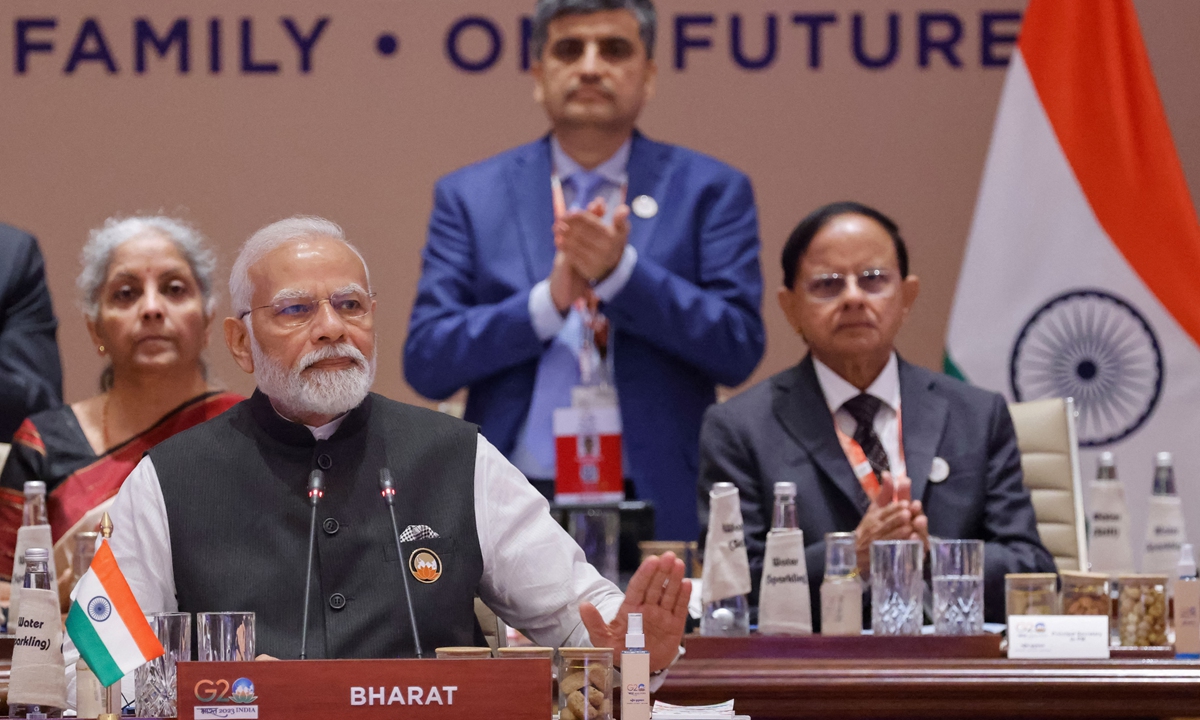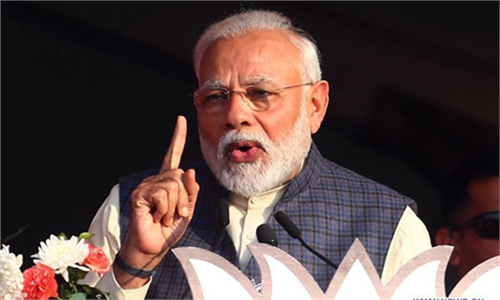
Indian Prime Minister Narendra Modi looks on during at the start of the second working session of the G20 Leaders' Summit at the Bharat Mandapam in New Delhi on September 9, 2023. Photo: AFP
During the opening of the G20 summit on Saturday, the name on the placard in front of Indian Prime Minister Narendra Modi read not "India" but "Bharat." This has fueled speculation within India and abroad about whether the Modi administration intends to change the name of the country.
However, this doesn't amount to a significant change in the official name because the opening sentence of India's constitution states, "India, that is, Bharat..." In other words, India has always had two names: "India" in English and "Bharat" in Hindi and several other languages. Additionally, there's another unofficial name, "Hindustan," which is commonly used by the public. These three names have different historical origins.
"Bharat" is derived from Sanskrit, and it seems to have the earliest historical roots. "India" also has ancient origins, originally coming from the Sanskrit "Sindhu," which means river. However, during British colonial rule in India, the British chose to anglicize this term, giving rise to the English name "India" that is still in use today. The Modi-led Bharatiya Janata Party (BJP) follows a well-known ideology of Hindu nationalism and believes that the English name "India" chosen by the British represents the colonial history. Therefore, they aim to discard it and replace it with the English transliteration of "Bharat" to break free from colonial influences.
In the context of Western-style elections in India, the issue of the country's name is inevitably becoming a new focal point in political party struggles. Currently, those who support Modi and used the "Bharat" label during the G20 summit, as well as those who refer to Modi as the "Bharat" Prime Minister, belong to the BJP and its followers.
However, the opposition parties, including the Indian National Congress and its allies, formed INDIA which stands for the Indian National Developmental Inclusive Alliance. Modi's use of "Bharat" in the invites to the G20 summit's dinner, followed by the use of the "Bharat" placard at the venue, is seen as a strategy to provoke a backlash against the INDIA alliance, with the intention of rallying Hindu voters against them.
Whether India will completely change its official name as commonly understood remains to be seen. So far, Modi has not officially announced any plans to do so. The BJP is expected to hold a special parliament session later this month. Some believe it may decide whether to initiate legal action to change the country's name. According to the Indian Constitution, changing the country's name would require a two-thirds majority vote in parliament, and the BJP holds only 303 out of 543 seats, which is far from a two-thirds majority. Therefore, it is possible that the Modi administration may not formally seek to change the country's name but instead continue to use "Bharat" in official documents, as it is a name recognized by the Indian Constitution and does not pose a legal issue; it's mainly a matter of public familiarity. The Modi administration's main goal in the near future is likely to create a new habit of referring to India by the name "Bharat."
Many developing countries around the world have changed their names in the past half-century, especially in Asia and Africa, primarily as a reflection of anti-colonialism or nationalistic sentiments. For example, Sri Lanka changed its name from "Ceylon," the name used during British colonial rule. In Africa, Cote d'Ivoir was formerly known as the "Ivory Coast," and Ghana was originally referred to as the "Gold Coast," whose former names clearly reflect the labels imposed by greedy colonial powers. Thailand, formerly known as "Siam," changed its name to emphasize the dominant ethnic group, the Thai people. The Philippines also attempted to change its name to "Maharlika" twice to move away from the name imposed by Spanish colonizers, but these attempts were unsuccessful.
Changing the Chinese name for India to "婆罗多" (Pólúoduō) or "巴拉特" (Bālātè), is not necessary. The name "印度" (Yìndù) was introduced to China by the Tang Dynasty monk Xuanzang. Prior to that, Chinese historical texts referred to India as "身毒" (Shēndú), "天竺" (Tiānzhú), or "贤豆" (Xiándòu), which were different Chinese phonetic renderings of a similar foreign name. Xuanzang believed that the previous phonetic renderings were inaccurate, so he introduced the term "印度." The word "印度" in Chinese also indirectly confirms that the name "India" is not merely a random invention of the British colonial period. It has its roots in Sanskrit, similar to the origins of the Chinese term "印度."
Even if the Modi administration were to adopt the name "Bharat" as the official name in the future, and if they do not request China to do the same, it would still be reasonable for China to continue using the name "印度." This would not imply any lack of respect for India. Furthermore, the current Indian Constitution does not exclude the use of the name "India." Of course, if India were to amend its Constitution and officially abandon the name "India," the situation might change accordingly.
The author is a Chinese media professional. opinion@globaltimes.com.cn


